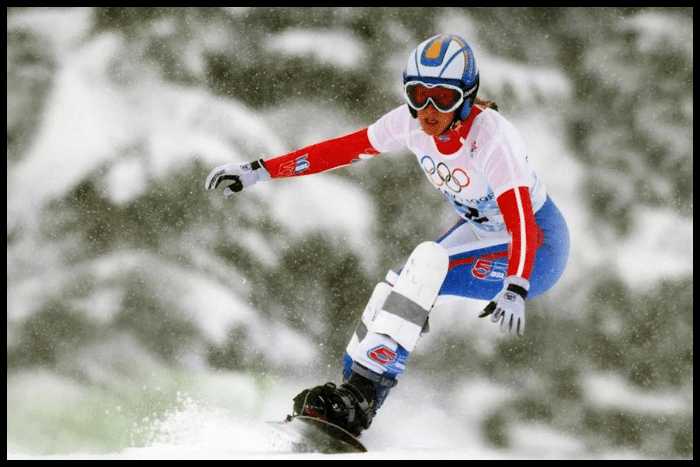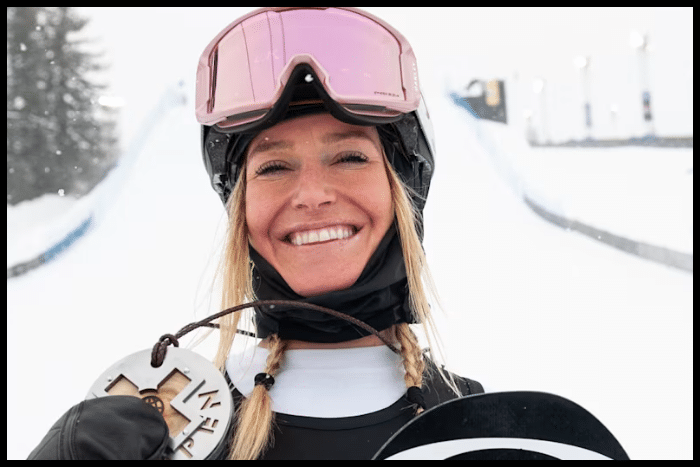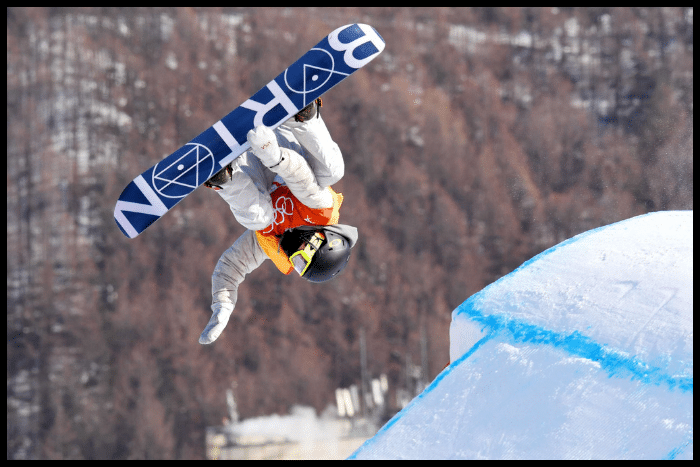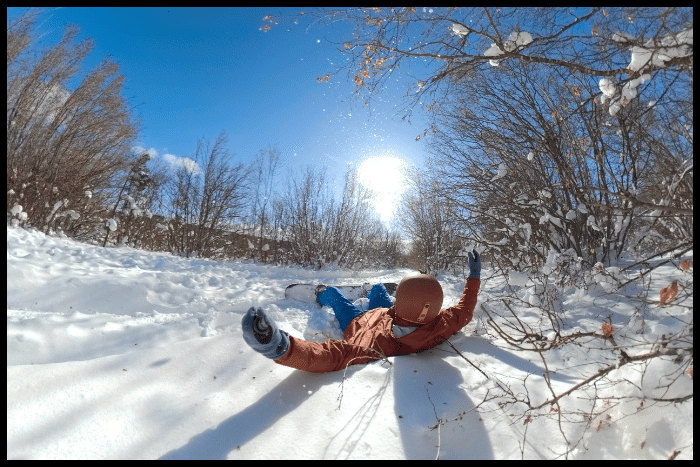While there is plenty of glory in snowboarding competitions like the World Cup and World Championships, nothing quite compares to the magnificence of the Olympic Games. The Olympics are quite literally the gold standard in sporting competition. For most serious athletes in any sport, the opportunity to compete is their ultimate dream.
From Shaun White’s Halfpipe dominance to Jamie Anderson’s slopestyle and big air medal haul, the Winter Olympics has seen many snowboarding legends since its adoption. Today, a new generation of riders like Chloe Kim and Red Gerard are carrying the torch for the future of Olympic snowboarding.
Below, we’re going to take a look at some of the most prominent snowboarding Olympic winners and their memorable moments, but not without looking at how they got there first and what it takes to claim victory at the Games.
The Stars of Olympic Snowboarding
Let’s take a look at some of the standout stars of the competition. While we can’t list every Olympic snowboarding medalist, we’ll take a brief look at some of the standout champions of each discipline.
Also, if you, too, wish to join these names some day, do read my article on how to snowboard at the Olympics?
1. Slalom Speedsters
Slalom snowboarders are masters of precision and agility, navigating rapid courses while making split-second decisions.
Among these exceptional athletes, snowboarders Karine Ruby and Benjamin Karl stand as beacons of the discipline.
Karine Ruby
French snowboarder Karine Ruby, a trailblazer of the sport, triumphed in the Women’s Parallel Giant Slalom at snowboarding’s inaugural Winter Olympics in 1998, making her the first-ever woman to receive a medal in the Olympic event.
Ruby’s gold medal victory highlighted her exceptional technical finesse.
While she only managed second place at the following games, she inspired a generation of future slalom athletes to follow in her footsteps.

Benjamin Karl
Benjamin Karl, a formidable force from Austria, won his first medal, a silver, at the 2010 Olympic Games in Vancouver, Canada.
He competed again in 2014, where he came in third, a result that may have shaken the faith of less dedicated athletes.
While he didn’t place in the 2018 Olympics, he hit his stride with a string of championship successes, culminating with an eventual gold medal at the Beijing 2022 Games.
Karl’s success shows just how much mental fortitude goes into becoming an Olympic gold medalist, and that skill can only take you so far if you can’t overcome adversity to win.
2. Halfpipe Heroes
Mastery of the vertical arena known as the Olympic Halfpipe requires aerial artistry, unmatched innovation, and the ability to pull off breathtaking maneuvers.
Among these exceptional athletes, US snowboarders Shaun White and Chloe Kim have left an indelible mark on the Halfpipe event.
Shaun White
Even the most casual snowboarding fans have likely heard of Shaun White, as he was arguably the first rider to reach celebrity status thanks to his skills on the mountain.
After winning medals at three successive X Games, White entered his first Olympic Halfpipe event in 2006 at just 19 years old and, despite nearly getting eliminated in the first round, walked away with the gold.
White also took first place in 2010 and 2018, but after a fourth-place finish in 2022, decided to take a well-earned retirement from competitive snowboarding.
Chloe Kim
At just 23, Chloe Kim is a snowboarding prodigy who, despite having achieved so much already, is still in the early days of what is sure to be an illustrious career.
At her first Olympics in 2018, Kim took the women’s Halfpipe gold medal at a mere 17 years old, making her the youngest woman to achieve Olympic gold in the event.
At the following Olympics in 2022, Kim defended her title with an impressive first run that was enough to secure her victory. She became the first female snowboarder to win back-to-back golds in the halfpipe.
3. Slopestyle and Big Air Pioneers
Slopestyle and Big Air events are showcases of airborne creativity and nerves of steel, where athletes push the boundaries of what it’s possible to achieve on a snowboard.
Among these daredevils, snowboarders Jamie Anderson and Mark McMorris stand out, albeit for slightly different reasons.
Jamie Anderson
Jamie Anderson of the United States has been in the game for a long time, winning a bronze medal at the 2005 Winter X Games when she was just 15.
She saw a string of podium appearances before she made her Olympic debut at Sochi in 2014.
This was the first year the Slopestyle event made an appearance, so when Anderson claimed gold, she was the first woman to do it.
At the 2018 Olympics in South Korea, Anderson won the Slopestyle gold again, making her the first woman to win concurrent golds in the event and taking silver in the Big Air event.
Interestingly, Anderson credits both yoga and meditation to her success on the slopes.
Although she didn’t make the podium in 2022 and is currently taking time off due to pregnancy, she has no plans of retiring just yet.

Mark McMorris
Canadian Mark McMorris has built a reputation as one of this generation’s best freestyle snowboarders, having won a record 22 X Games medals, tied only with Jamie Anderson.
While McMorris has yet to take home an Olympic gold, he has three slopestyle bronzes from 2014, 2018, and 2022, respectively; his unbelievable resilience sets him apart from the pack.
Just before the 2014 Olympics, McMorris broke his rib while competing at the X Games; overcoming the injury to reach third place was a remarkable achievement.
He broke his femur in 2016 but recovered. In 2017, he had a near-fatal snowboarding accident that resulted in a collapsed lung, ruptured spleen, and fractured pelvis, among other severe injuries.
Two surgeries and a mere 11 months later, McMorris was back at the Olympics to claim the bronze, which he did again in 2022.
Few Olympic athletes have been through what he has and still come out a champion.
4. Boardercross Champions
Added to the Olympic snowboarding event lineup in 2006, boardercross is a head-to-head racing discipline that demands a focus on speed, strategy, and agility.
Two athletes that have stood out in boardercross since its adoption are Seth Wescott of the United States and Czech sensation Eva Samková.
Seth Wescott
Wescott, known for his fearless approach and aggressive racing style, was the first gold medalist in the discipline when he took first place in Turin in 2006.
However, his victory wasn’t without some off-slope controversy.
In an interview some years later, Wescott confessed that he turned down President George W. Bush’s invitation to the White House out of opposition to his foreign and domestic policies, which stirred up a few of the former president’s supporters.
However, none of this affected Wescott’s ability to win.
He miraculously defended his Boardercross gold medalist status in 2010, starting the race in last place but managed to pass into pole position on the course’s final jump.
Eva Samková
Eva Samková started her snowboarding career in the slopestyle category but switched to boardercross after one too many injuries in the snowpark.
It turns out that boardercross is where Samková excels, and in 2014, she claimed the Czech Republic’s first gold medal in the event.
To the bemusement of a worldwide audience, Samková competed with a marker pen mustache drawn on her lip, which she claimed was for good luck, something she’s repeated in subsequent races.
Samková added a bronze to her Olympic medal attempt in 2018.
While she missed out on the 2022 Olympics after breaking both ankles during a World Cup event, she made an astounding comeback in 2023, where she took gold in the snowboarding world championships.
Defining Some Special Moments of Snowboarding Olympic Winners
Throughout the history of snowboarding at the Olympic Games, a handful of occasions stand out above all others – moments that truly define the sport’s unique ability to stun and amaze.
Shaun White’s Iconic Victory Lap
Snowboarding legend Shaun White has been responsible for more than his fair share of historic snowboarding moments.
But, perhaps his most incredible was his Halfpipe performance at the 2010 Olympics in Vancouver. White’s first run in the final was strong enough to secure a gold medal victory without a second attempt.
Still, the maverick snowboarder had no intention of resting on his laurels.
Instead, he used the opportunity to pull off a brand new trick – the Double McTwist 1260 – which boosted his final score even higher.
Multi-skilled Ester Ledecká’
At the South Korean Olympics in 2018, the Czech Republic had an ace up their sleeve with Ester Ledecká.
Not only was Ledecká an accomplished slalom snowboarder, but she was also a highly skilled alpine skier, so when she competed in her second Olympic games, she decided to enter both events.
Not only did this make her the first person to compete in the Winter Olympics in two separate sports, but she took things a step further by winning the gold in both, a feat no other athlete has achieved since.
Red Gerard’s Eventful Day
Competing for the United States at the Pyeongchang Olympics in 2018, Red Gerard made headlines for more than his slopestyle gold victory and the fact that he was the youngest snowboarder to do so at the Games.
Perhaps showing his age at just 17, Gerard spent the night before the event partying and binge-watching Netflix.
After nearly oversleeping and missing the competition and borrowing his roommate’s jacket to replace his own, which he’d misplaced during his misadventures, Gerard still managed to work his way up the standings from last place to first.
To top things off, the young champion promptly forgot about the rolling TV cameras when his score was announced and let out a few choice expletives, which ironically only further endeared him to the global audience.

The Evolution of Snowboarding at the Olympics
Now that we’ve covered the victors, it’s worth looking at how snowboarding even became an Olympic event in the first place.
It was a hard-won battle without which these legends would not have had the opportunity to show what they were made of.
These days, snowboarding is seen as one of the main highlights of the Olympic Games, with many fans ranking it as their favorite Winter Olympic sport.
Therefore, it seems strange to think that not only was snowboarding only introduced as an event in 1998 but that it also faced considerable resistance.
The evolution of snowboarding at the Olympics has been a long journey, with its proponents fighting tooth and nail to get the sport recognized on the international stage.
Despite the sport existing in an early form as far back as the 1960s, it took until the late 80s before most ski resorts would even let snowboarders use their lifts, so getting snowboarding into the Olympics was going to take a lot of time and effort.
However, despite organizers’ skepticism about whether the sport, with an unconventional nature and counter-cultural reputation, was suitable for the Olympics, snowboarders and snowboarding fans eventually won.
Whether this was due to the International Olympic Committee truly recognizing the beauty of snowboarding or that they could see the X Games taking younger audiences away from the less-extreme Olympic Games is still up for debate.
Fortunately for us, snowboarding at the Olympics has only gone from strength to strength, showcasing talent from all across the planet and raising the sport’s profile to global heights.
You can read more about snowboarding’s Olympics history in my article on the same.
The Path to Victory
After we’ve taken a look at some specific winners and their world-beating feats, it’s important to recognize and appreciate the extreme amount of physical and mental effort it takes to become an Olympic snowboarding champion.
Athletes seeking Olympic glory pursue an intense training regimen that involves honing their technical skills, refining their riding techniques, and mastering – sometimes even inventing – highly complex tricks.
Each athlete will also have a customized training regimen based on the discipline in which they compete: slopestyle, big air, halfpipe, or boardercross.
However, pure skill isn’t enough to compete at the biggest sporting event on the planet.
Olympic-level snowboarders will employ strength and conditioning coaches to boost their fitness to the levels required for the global stage.
Mental preparation for the Olympics is almost as important as the physical and skills-based training athletes undergo, so it’s not unusual for snowboarders to work with sports psychologists to help handle the pressure of performing in front of an audience of billions.
The path to victory is not without its challenges. Athletes face setbacks like injuries, failure to qualify at certain events, and having to stay ahead in a sport that’s continually evolving.
Ultimately, the journey to the Olympics requires exceptional dedication, tireless effort, and an unrelenting commitment to reaching the pinnacle of the sport.

Like Everything, Snowboarding Feats Demand Discipline
Snowboarding’s elevation to Olympic status took years of passion, hard work, and dedication from the global snowboarding community of riders and fans alike.
They saw snowboarding’s potential as a sport, and the result has been dozens of competitors overcoming adversity and pushing their abilities to perform incredible feats of athleticism in front of billions around the world.
Since snowboarding’s inaugural Games in 1998, we’ve already seen a generation of champions come and go, pushing the limits of what we thought was possible.
Now, the new generation of Olympic winners is here, and they’re continuing to surprise us, surpassing the abilities of even the earliest icons of the sport.
